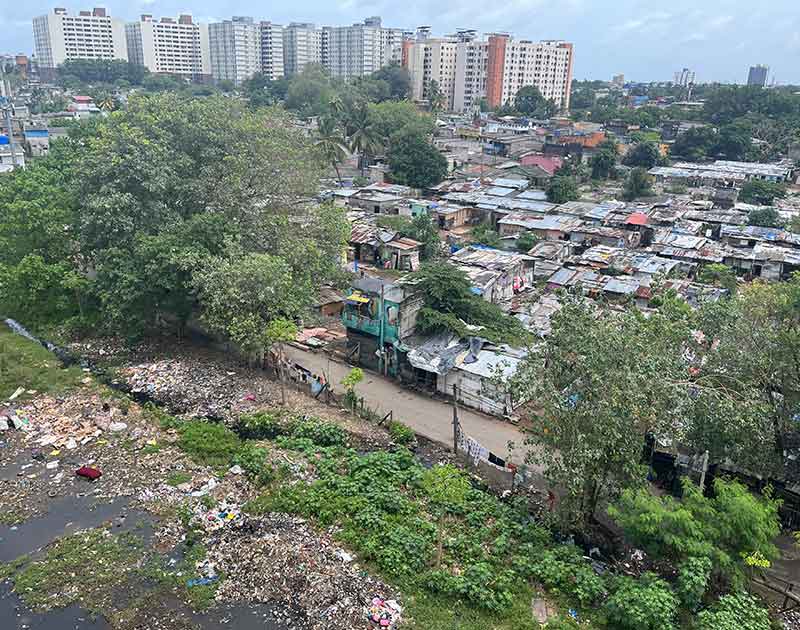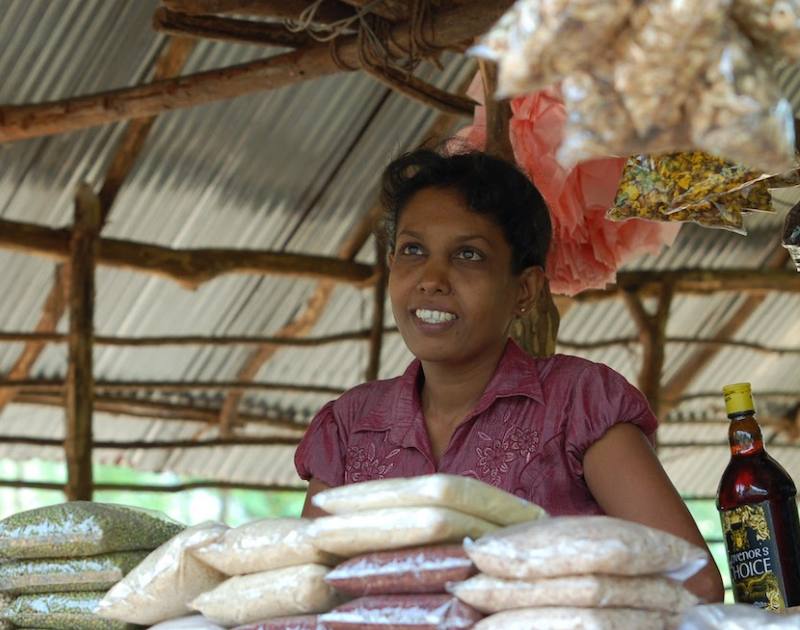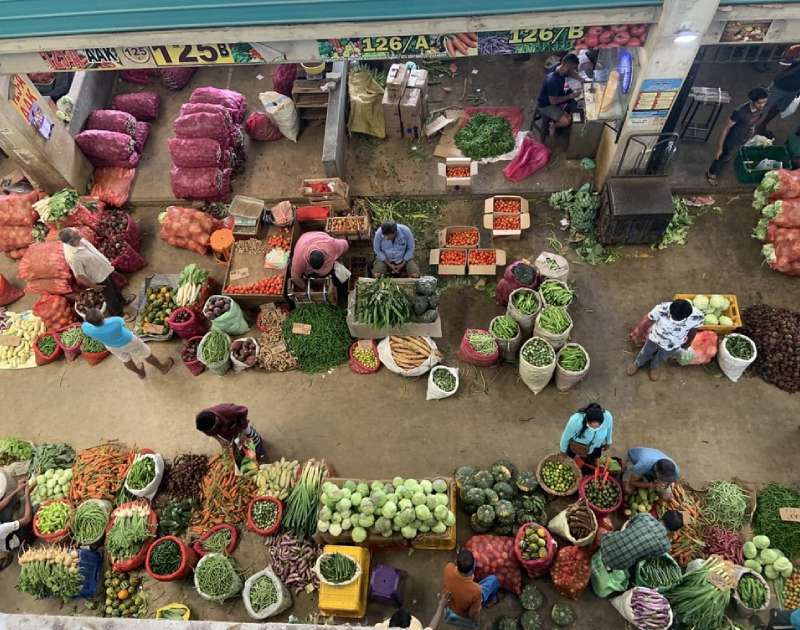
- Home
- Knowledge Insights
- A research methodology to understand stories of development and displacement in two of Colombo’s markets
Giving voice to counter narratives in word class city making
Much of Colombo’s post-war development has prioritised the aesthetics of the city, rather than the functionality of it. Sri Lanka’s post war development paradigm included visions of turning Colombo into a “world class city”, focusing on vanity projects that would beautify the city. Under the Mahinda Chinthana, the goal was to transform Sri Lanka into a strategically important economic centre of the world which encompassed “transforming Colombo and its metropolitan area into a modern, worldclass, slum-free economic hub”. As part of this, development projects saw mass displacement. The “Urban Regeneration Programme”, for example, saw the planned dispossession of around 68,000 families, with many facing military-backed forced evictions, all in order to fulfil the imaginaries of a “world class city”.
In the bid to build a world class city, many of Colombo’s working class poor found themselves being displaced- displaced from both places of residence and places of business, as they did not align with Colombo’s evolving identity.
Two of Colombo’s main vegetable and fruit wholesale and retail markets that have been impacted by this new development paradigm, are the Manning Market in Pettah and the Nagalagam Market based in Thotalanga. While each market encapsulates a distinct developmental history, they each possess a unique experience following their respective redevelopments, aligned with the vision of becoming a world-class city.
This article presents a methodology, following an ethnographic approach to understanding development and the problems associated with it for those whose views are seldom included in the new city identity. An ethnographic approach was chosen as it is a methodology that provides holistic insights into people’s views and actions, which is embedded in the location which they inhabit. We argue that to understand and analyse the complexities of these markets, and the nexus of interaction amongst vendors, built environment, infrastructure, and customers – an ethnographic approach yields thick descriptions that capture and represent the lived experience of each market, which is often at odds with the vision under which they were displaced.
The methodology is as follows and is expanded in subsequent sections:
Understanding context
The development of each of the markets doesn’t stand in isolation, but rather is embedded in a context of beautification, and aesthetisation which was a dominant narrative at the time of development. Understanding the context behind these developments helps to contextualise the motivations behind each redevelopment project. As such, the question of “who is the market for” and “what purpose does it serve”, is considered less when understanding that its development fits within a city’s transformation into an aspired state. This dynamic introduces a tension between the priorities of aesthetisation and functionality, with the former usually gaining prominence, which was the prevailing trend during the period of development.
Secondary and primary research to understand the historical development of the market
Secondary research was conducted to understand the individual historical development of each market. For the Nagalagam Street Public Market (Nagalagam Market), to bridge the lack of literature available, we conducted semi- structured interviews with Community Leaders, to understand how the market developed over time. Through these conversations, we gained insight that the public vegetable and fruit market has long been at the heart of their community, with much of the Thotalanga area developing around the concentration of vending activity. In 2018, a new and improved marketplace replaced the old market, boasting modern amenities, designated spaces for vendors and shelter from the rain and heat. Street vendors who were operating on the streets in Thotalanga, were relocated into this market.
The Manning Market has considerably more literature, which highlights how the Manning Market was originally located in Pettah, and was established over 150 years ago. The market was located between Olcott Mawatha and Bastian Mawatha, in the heart of the city centre close to main transport hubs, and spread over 3.5 acres of land. In 2020, amidst COVID-19 lockdowns, vendors of Manning Market were moved to Peliyagoda, the site of a brand new market, which was supposed to provide vendors with over 1200 shops, modern amenities, better storage, parking facilities and waste management, all with the vision of providing a “modern marketplace for traders as well as customers”.
Whilst both markets were sites of re-development, one being in-situ development and the other, relocation – both developments resulted in displacement of vendors.
Visiting markets at multiple times of the day
Visiting each market multiple times prior to starting our interviews, was vital to understanding how the market functioned. Visiting the Manning Market at 3:00 AM when it started operations gave us a deep understanding of how the market operated, especially when goods from around the country were being unloaded. Being in the market during the day allowed us to also understand how vendors interacted with their customers, with suppliers, and with different stakeholders of the market. We were then able to identify which stakeholders would be essential to speak to as part of the next phase of the methodology, the interviews.
Conducting semi structured interviews with vendors operating in each market
At the Nagalagam Market, we conducted interviews with vendors inside and outside the marketplace, as many vendors were vending from makeshift stands on the roads adjoining the market despite having a dedicated marketplace. These interviews with vendors helped us confirm our observations from visiting the markets. We aimed to keep each conversation to a maximum of 30 minutes each time so as not to impact their business, whilst also being mindful and giving them space to conduct operations whilst speaking to us, which gave us another layer of insight as to how they conduct operations on a daily basis.
It was through these interviews that we were able to identify that many of the vendors in the Nagalagam Market had moved back to the roadside, as business was significantly better there, leaving empty stalls inside the market. As one vendor pointed out, “When we were inside the market, we saw that those on the roadsides were getting much more business than us, as passers-by would stop and buy produce. Hardly anyone goes into the market.” The remaining vendors who were still operating inside the market, were vendors doing a combination of both wholesale and retail and couldn’t move onto the road given the scale of their operations.
Similarly, vendors at Manning Market spoke of how the new market didn’t deliver on the modern amenities that were promised to them. They noted that they would rather be at the old market than the new, as their operations would go on until 8:00 PM, however, their operations in the new market finish at 1:00 PM, as they have no business. Whilst vendors expected to receive a modern marketplace, they were greeted with stalls that were half the size of the stalls originally promised to them, vendors having to share plug points for scales, and a significant fall in number of consumers accessing the market. Although their old location lacked infrastructural amenities such as storage space and stall size, the new market came with an increase in rental cost too.
Despite being promised improved amenities and modern facilities, vendors at both markets have a preference to their old place of operation. This highlights that infrastructural amenities and ‘modern’ facilities aren’t always the most important factors when building a market – rather accessibility for customers is. A participatory approach to planning would have highlighted this – if the planners were truly concerned with the functionality of the built environment.
Conducting semi-structured interviews with vendors and households who frequent the market
The Nagalagam Market is predominantly frequented by residents for household consumption. Conducting semi-structured interviews with households in neighbouring wattes enabled us to understand how they interact with the market, and confirmed much of what the vendors themselves told us, as households preferred to shop from vendors on the roadside, as opposed to inside the market.
Similarly, speaking to vendors from an area close to the Manning Market, gave us further insight into how they interact with the market, and the challenges they are facing with increased fuel costs in accessing the Manning Market.
These interviewees were not only useful in understanding interactions with the market, but also understanding how these markets affect the food plates of households. Given that the Manning Market is the main wholesale market for vegetables and fruits in Colombo, much of the produce sourced by neighbourhood vendors in Colombo is sourced from this market. Hence, any increased costs faced by wholesale vendors in the markets, or increased costs in accessing the market usually has downstream impacts to customers, in the form of higher prices.
Analysing the value chain of different products and their infrastructural considerations
Stemming from the household and vendor interviews, we identified produce that was frequently purchased by consumers, and analysed their flows in the two markets. Although the newly built markets provided more infrastructural considerations than the previous locations of vending, these facilities were barely used, inaccessible, or didn’t suit vendors requirements. For example, fruit vendors were given no storage space for their produce, which resulted in them having to build additional structures (at their cost) to store excess produce overnight. Additionally, cool rooms that were promised to all vendors in the Manning Market, were designated exclusively for those who import fruit, making it inaccessible to vendors who source produce from the local economy.
Similarly, in Nagalagam Market, whilst vendors were promised access to better infrastructure, they preferred to vend from the roadside as infrastructure didn’t fully determine what they were able to sell, and they were able to rely on hybrid-forms of infrastructure. These included rechargeable lights, water from their homes nearby, or from the river bordering Thotalanga.
Multiple follow-up visits to the market
Conducting multiple follow-up visits to the market and vendors we interviewed helped us to strengthen our familiarity with the market and rapport with vendors. We visited the market over a period of five months,and witnessed how periods of crisis impacted the market. At the Manning Market, rising electricity tariffs in 2022 and 2023 resulted in stall rental costs being doubled, a cost which vendors were unable to bear. These visits also highlighted that whilst a crisis can have immediate impact, the impact can also be delayed – as vendors were having to contend with the belated impacts of the fertiliser ban which resulted in less supply and lower quality. As one vendor noted with reference to the relocation and rent increases, “by moving us to this space, they [the Government] have broken our business”.
It was evident through all these interactions and triangulation of evidence, that these two markets that the Government has built in the vein of modernity and development have not provided services beyond aesthetics. At both markets, the modern facilities have not substantially improved business, and vendors prefer the roadside or their old location as it serves their business better. However, unlike the vendors at Thotalanga who were able to move to the roadside, the vendors at Manning Market have nowhere to go, and must contend with operating from this new space. Understanding these stories of change helps us to better understand how the market functions, not only on a day-to-day basis but also how it faces and responds to periods of crises. The operations of the market are complex, and when dealing with markets that are the main hubs of wholesale fresh produce to Colombo, it is imperative to accurately capture their experiences – as it directly impacts the food security of the city. Given the complexity of the operations and the multiple interactions that take place within its space, a single visit would not have been sufficient to capture the complexity and diversity of each market, whilst also building trust with vendors.
This research is a part of two ongoing projects with the Institute of Development Studies, UK – the Living Off-Grid Food and Infrastructure Collaboration and ‘Fruits and Vegetables for Sustainable Healthy Diets’ Initiative (FRESH).
References:
Aisha Nazim. 2018. ‘Colombo’s Dying Market Place: The Manning Market’. Roar Media, April 2018. January 2024. https://roar.media/english/life/srilanka-life/colombos-dying-market-place-the-manning-market.
Perera, Iromi. 2020. ‘”We Can’t Feel the Earth beneath Our Feet Anymore”: Dispossession and High-Rise Living in Colombo’. Polity 8 (1 & 2): 51–57.
Reeves, S., A. Kuper, and B. D. Hodges. 2008. ‘Qualitative Research Methodologies: Ethnography’. BMJ 337 (aug07 3): a1020–a1020. https://doi.org/10.1136/bmj.a1020.
UDA. 2023. ‘Western Province: Development Projects’. Urban Development Authority. 2023. https://www.uda.gov.lk/project-western-province.html.
Uditha Jayasinghe and Devjyot Ghoshal. 2022. ‘Fertiliser Ban Decimates Sri Lankan Crops as Government Popularity Ebbs’. Reuters, 3 March 2022. https://www.reuters.com/markets/commodities/fertiliser-ban-decimates-sri-lankan-crops-government-popularity-ebbs-2022-03-03/.
World Bank Group. 2012. ‘Turning Sri Lanka’s Urban Vision into Policy and Action (English)’. Policy Note 73182. Washington, D.C: World Bank Group. https://documents.worldbank.org/en/publication/documents-reports/documentdetail/665641468308350890/turning-sri-lankas-urban-vision-into-policy-and-action.


